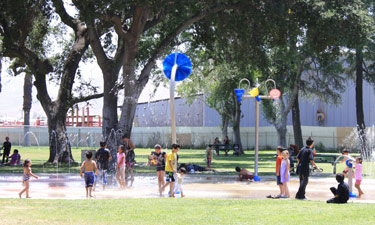 To children, the effect is magical: Sprays of water suddenly appear from beneath the ground, fall at random on the laughing and screaming kids, and then just as quickly disappear back into the ground. But for the adults who work to provide spray parks and splash pads as amenities for their communities, those questions cannot remain mysteries. So just where does the water come from and where does it go?
To children, the effect is magical: Sprays of water suddenly appear from beneath the ground, fall at random on the laughing and screaming kids, and then just as quickly disappear back into the ground. But for the adults who work to provide spray parks and splash pads as amenities for their communities, those questions cannot remain mysteries. So just where does the water come from and where does it go?
With water shortages affecting more and more jurisdictions, and increasing demand for spray parks and splash pads, agencies are examining new alternatives for the use, reuse, and disposal of spray park water. Some of the options include recirculating the splash pad water, storing the water in a tank underground and allowing it to percolate back into the groundwater, or reusing the water for either subsurface or above ground irrigation.
Each option brings its own pros and cons. Patricia Rotschild, marketing and design specialist with Vortex Aquatic Structures International, notes that recirculating systems are most common on larger splash pad installations. However, the water must be resanitized before it can be reused and the treatment requirements vary from state to state. Some states require chlorination and even UV treatment.
In Colton, California, Director of Community Services Bill Smith says that the city chose an above-ground irrigation water reuse option for its new spray park in an effort to be conservation-conscious. The captured water irrigates the surrounding park and sports fields.
”We likely would have installed the splash pad regardless, but this savings allowed us to incorporate other amenities into the park project,” he explains.
Rotschild describes how in an above-ground irrigation reuse system, the splash pad water is stored in an underground tank near the splash pad. Because the water will be used above the surface where people may come into contact with it, the water requires more resanitation than with a sub-surface irrigation system, according to Rotschild.
“The system currently works very well,” Smith says. “I don’t have numbers as far as number of gallons, etc., but clearly the captured water that is reused saves freshwater.”
In Abbottsford, British Columbia, a water shortage in 2007 prompted the Parks, Recreation, and Culture Department to find new ways to reduce its potable water use. Its older spray park at Mill Lake Park used 160 gallons of treated water per minute, with all of that water draining into the sewer system.
“I looked at recirculation systems and with the local Health Board, there was no way to get approval for this type of system without a fight and a lot of headaches,” says landscape architect Scott Watson, park planner and designer for the City of Abbottsford. “I started talking with our water engineers about using well water and the more we talked, the more people liked the idea.”
Because the new splash pad uses well water (tested twice yearly by the Health Board) and not treated water, new options opened up for water disposal such as percolation. In a percolation system, Rotschild explains, water is stored in a porous underground chamber where it naturally filters through the earth, often making its way to a nearby pond or wetland, or it can be used to replenish the natural water table.
“Abbotsford's subsurface consists of mainly gravel, so with the right design we were able to dispose via a rock pit,” Watson says. “The end result is that we have an excellent spray pad that uses a maximum of 70 gallons per minute of non-treated water (compared with the previous spray pad use of over 160 gallons per minute of treated water) and the spent water is returned to the soil. Hopefully, some of it is making its way back to the aquifer; otherwise it is probably ending up in Mill Lake….I would like to say that if a splash pad could be 'green' this would be about as best as you can get.”
“It’s not just a trend, it’s actually a movement,” Rotschild says. “People need to aware of it now, if they’re building splash pads--they’re going to be around for a long time….They have to be conscious now of how it’s going to work for the future.”
Elizabeth Beard is Managing Editor of Parks & Recreation.

